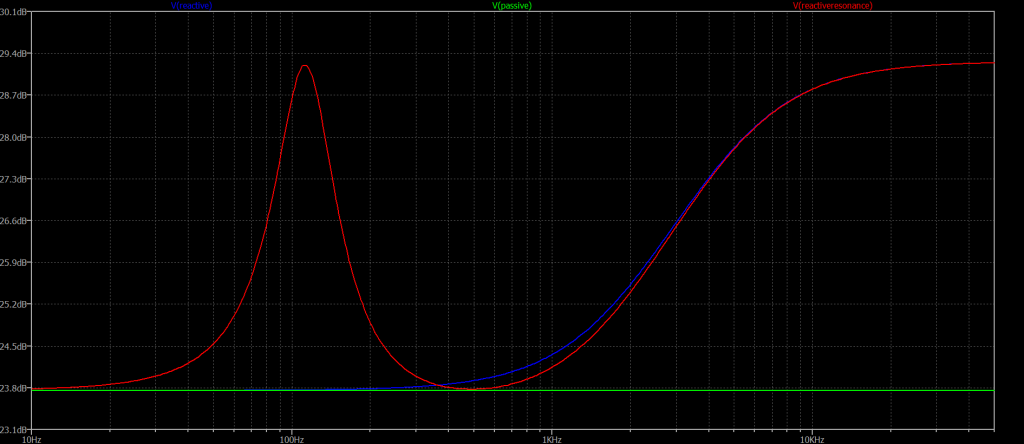ReactIR
REACT:IR - THIS PRODUCT IS DISCONTINUED!
Valve (tube) guitar amplifiers have relatively large output impedance due to the output transformer. The guitar cabinet represents a complex reactive load to the amplifier and drastically affects the frequency characteristic of output signal. Adding to this, the majority of guitar amplifiers have negative feedback. This means that some part of output signal returns again to the input of the power amplifier and mixes with the main signal.
Thus, when we speak about a load box, it’s important to understand principles of the device’s operation and its influence on signal. Guitar speaker manufacturers often publish the impedance curves of their respective products. Usually, guitar speaker have their largest impedance at lower frequencies around 70-90 Hz. When inside a cabinet, the peak at low frequencies resides slightly higher, for example, in 4×12 cabinet, the peak is located around 100-115 Hz due to the cabinet construction. Thus it’s important to reproduce not only speaker characteristics, but also the characteristics of the entire cabinet.
Historically, different equipment manufacturers have produced different types of load boxes. Initially, a simple passive type of load is used. Then, reactive types were introduced. However, the term, “reactive”, can refer to only high frequency component without low frequency component. Thus, the term, “reactive-resonance”, load was introduced which means correction not only of high frequencies, but also low frequencies. The graph below represents the influence of different load types on frequency characteristics of signal.
React:IR allows usage of all three regimes: passive, reactive and reactive-resonance. The respective modes can be set using switches in the Loadbox section on the front panel of the device.In addition, the device has attenuator, which allows the usage of an amplifier at maximum volume, while listening at quiet “TV” loudness.
React:IR has a number of FX-effects:
- Noise Gate
- Tone stack – amplifier Tone Stack emulation with several models of popular amps
- PA Curve – amplifier-cabinet interaction curve
- 5-band paragraphic equalizer with high cut and low cut filters (LowPass and HighPass)
Tone Stack emulation can be used in when running a distortion stompbox directly into the line input, for emulation of frequency response of guitar amplifier clean channel.
Impedance Curve emulation can be used for guitar preamp connection into line input, in this case frequency response modified to emulate connection trough guitar power amp.
About power rating of React:IR:
React:IR loadbox has 100W rating at 8 Ohm. What does it mean? It’s mean that 100W of distorted (high gain) signal can be sent to loadbox, this equivalent to ~150W of sine signal.
One need to understand : when you set master volume of amplifier to 12 o’clock you get ~12% of power. Starting from 12-13 o’clock of master volume, phase inverter begin overloading and this sounds more fuzzy for high gain signals. This exactly why players, when using high gain, don’t like to overdrive power amp section instead using master knob up to 12-13 o’clock. Another case is crunch and clean tones ( both are crunch -) ): they use phase inverter overloading to get more tasty tone.
There are many amps on a market with power more than 100W – Triple Rectifiers, 5150 family, Herbert and others… What will happen with React:IR when using it with these amps? Nothing! It will work properly, but device can be more warm, fan will work at maximum speed. With master volume up to 12-13 o’clock – you can use any tube guitar amp up to 200W without any limits.

- Power switch
- Headphones output – 32 Ohm
- Auxillary input for connecting external sources like players, smartphones etc.
- Headphones volume
- Impulse loader input level
- 5-segment input indicator, for optimal result adjust input level to be in yellow/orange zone, not exceeding red segment.
- Main screen
- Output clipping/input signal presence indicator. When Clip indicator lights green, signal is present at input, when clipping occurs at output of impulse loader, indicator switches to red.
- Menu button, press to enter menu.
- Back button, press to return to previous menu level.
- Control dial. Rotate to navigate or change parameter, press to select or set.
- Attenuator level
- Resonance switch
- Load mode switch
- Fan, do not block air flow for proper ventilation.
- Through output for cabinet connection, when jack inserted, internal load and attenuator are disconnected. Careful with amp level, when switching to this output.
- Input for power amplifier output. Reactive load is suitable for impedance of 8 Ohm with nominal power of 100 Watt.
- Attenuator output
- Line input/load box output, jack tip is line input for external signal sources for IR loader, jack ring is load box output for connection to external FX devices. When mono jack is inserted connector works as line input, disconnecting IR loader from load box.
- Ground Lift switch for D.I. OUT, useful for solving ground loops problems.
- D.I. output allows recording raw signal from load or cabinet before impulse loader section. Output is balanced and can be powered from phantom power.
- Ground Lift switch for LINE OUT
- Balanced line output for recording signal after impulse loader section.
- Pad switch for LINE OUT, when PAD pressed, output level reduced to microphone level.
- USB connector for remote control from PC/MAC and impulse response uploading to device.
- MIDI In connector for preset switching from MIDI.
- Power supply connector, use 7-12 V DC power supply with any polarity.
- S/PDIF Out.
- Attenuator Out Impedance selector.
ADC and DAC characteristics:
- Sampling frequency up to 192 kHz
- Resolution: 24 bits
- Noise level : -109 dB (A-weighted)
Power supply:
- 9 V DC, any polarity
- Consumption: up to 250 mA.
- Measured latency 1.3 msec
- 32 bit floating point, 44.1 kHz
- Internal impulse format: 44.1kHz, 32 bits, maximum length 8320 samples (188 msec).
- 25 impulse slots/preset
Dimensions & weight
- Width x depth x height: 483 x 187 x 44 (mm)
- Weight: 3 kg (device only )
Equipment and packaging
- 1 x React:IR
- 1 x Power Supply
- Packing size 60x29x8cm
- Packing weigh 3.8kg
Reactive loadbox
Input impedance : 8 Ohms
Admissible power : 100W RMS
Connectors
- Speaker Input: 1/4″ (6.35mm)Jack unbalanced (TS, Tip/Sleeve)
- Speaker Thru: 1/4″ (6.35mm)Jack unbalanced (TS) – Directly connected to Speaker Input. Disconnects the loadbox when used.
- Insert: 1/4″ (6.35mm)Jack unbalanced (TS, Tip/Sleeve) in insert mode or (TRS, Tip/Ring/Sleeve) in insert\out mode.
- D.I. Balanced Output: XLR.
- Main Balanced Output: XLR.
- Headphones: 1/8″ (3.5mm) TRS Jack – 32 Ohm
- Aux In: 1/8″ (3.5mm) TRS Jack
- S/PDIF output – RCA Connector – Sampling frequency 44.1 kHz. Resolution 24 bits.
- MIDI input – DIN5 Connector
New in gen. 3 :
Attenuator improvements
- Volume adjustment now more smooth
- Increased maximum output level of attenuator
- Added output impedance switch to accomodate for different cabs impedance ( Note: Loadbox input is still 8 Ohm only )
Improved input level indicator
- Now it is better represents momentary input level
New in gen. 4 :
- Mode “OFF” of Resonance switch was changed;
- Internal technological improvements;



- Windows 32 bit;
- Windows 64 bit
- MacOS 64 bit
- Firmware
block diagram

